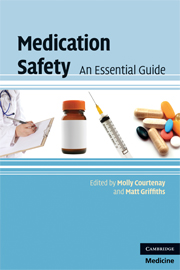Book contents
- Frontmatter
- Contents
- List of contributors
- Preface
- 1 Introduction to medication errors and medication safety
- 2 Safety in prescribing
- 3 Safety in dispensing
- 4 Safety in administering
- 5 Adverse drug reactions and drug interactions
- 6 Interface of care and communication
- 7 Parenteral drug administration
- 8 Calculations
- 9 Controlled drugs and patient safety
- 10 Reporting medication errors and near misses
- 11 Ensuring safety through evidence-based medicine
- Index
- References
8 - Calculations
Published online by Cambridge University Press: 22 January 2010
- Frontmatter
- Contents
- List of contributors
- Preface
- 1 Introduction to medication errors and medication safety
- 2 Safety in prescribing
- 3 Safety in dispensing
- 4 Safety in administering
- 5 Adverse drug reactions and drug interactions
- 6 Interface of care and communication
- 7 Parenteral drug administration
- 8 Calculations
- 9 Controlled drugs and patient safety
- 10 Reporting medication errors and near misses
- 11 Ensuring safety through evidence-based medicine
- Index
- References
Summary
Introduction
In his report ‘Building a safer NHS for patients: Improving medication safety’ (DH, Smith, 2004), the Chief Pharmaceutical Officer (CPO), Dr Jim Smith, recognized calculation error as a key risk factor in the medication process. According to Lesar (1998), the most common preventable adverse drug events occur due to errors in prescribing of medicines, and of these more than 15% are due to errors in the use of dosing equations. The National Patient Safety Agency (NPSA) defines a complex calculation as one where more than one step is required for preparation and/or administration of a medicine (NPSA, 2007b). Examples quoted include infusions where the dose is quoted in micrograms/kg per hour or where there is a need for dose unit conversion such as milligram to millimole or percentage to milligram.
Inadequacies in the ability of healthcare professionals to perform calculations accurately have been widely reported. Wheeler et al. (2004), for example, reported that registered doctors had difficulties with drug dosage calculations, particularly when the strengths of solution were expressed as ratios or percentages. A further report (Wheeler et al., 2007) identified that newly qualified doctors and those working in community practice struggled significantly more, as well as those from certain medical schools.
The dispensing of a defective medicine, which led to the death of a 3-week-old baby (peppermint water containing an excessive amount of chloroform) by a preregistration pharmacy trainee and a pharmacist qualified for 21 months, resulted in an increased emphasis on calculation skills training for pharmacists by the Royal Pharmaceutical Society of Great Britain (RPSGB, 2007–08).
- Type
- Chapter
- Information
- Medication SafetyAn Essential Guide, pp. 113 - 138Publisher: Cambridge University PressPrint publication year: 2009



